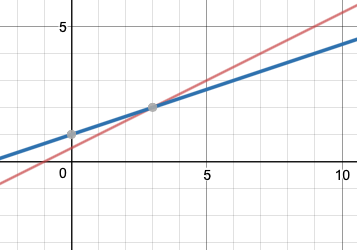Linear Algebra
Table of Contents
Introduction
Linear Equations
“the study of linear equations”
a linear equation in the variables $x_1, \dots, x_n$ has the form $a_1 x_1+\dots+a_n x_n = b$, with $a_1, \dots, a_n$ being the coefficients
geometric interpretation:
$ \begin{alignedat}{3} &n=1\qquad &&a_1 x_1 = b \longrightarrow x_1 = \frac{b}{a_1}\qquad &&\text{(point on a line in $\Re$)}\\\\ &n=2\qquad &&a_1 x_1 + a_2 x_2 = b \longrightarrow x_2 = \frac{b}{a_2} - \frac{a_1}{a_2}\qquad &&\text{(line in a plane in $\Re^2$)}\\\\ &n=3\qquad &&a_1 x_1 + a_2 x_2 + a_3 x_3 = b\qquad &&\text{(planes in 3D space, in $\Re^3$)} \end{alignedat} $
in general, $n-1$-dimensional planes in n-dimensional space
system of linear equations $x_1, \dots, x_n$ is a collection of linear equations in these variables.
$x_1 - 2x_2 = -1$
$-x_1 + 3x_2 = 3$
If you graph them, you get this:

the solution is the intersection.
a system of linear equations has:
- no solutions (inconsistent) – e.g. parallel lines
- exactly 1 solution (consistent)
- infinitely many solutions (consistent) - e.g. the same line twice
two linear systems are “equivalent” if they have the same solutions.
Matrix notation
| Equation | (Augmented) coefficient matrix notation |
| $\begin{alignedat}{6} &x_1 &&-&&2x_2 &&+&&x_3 &&= 0\\\\ & && &&2x_2 &&-&&8x_3 &&= 8\\\\ &5x_1 && && &&-&&5x_3 &&= 10\end{alignedat}$ | $\begin{bmatrix} 1 & -2 & 1 & 0\\\\ 0 & 2 & -8 & 8\\\\ 5 & 0 & -5 & 10 \end{bmatrix}$ |
the strategy to solve is to replace the system with an equivalent system that is easier to solve.
elementary row operations:
- replacement: add rows
- scaling: multiply by constant (non-zero scalar)
- interchange: swap two rows
all of these are reversible & don’t change the solution set.
Matrices A and B are equivalent ($A \sim B$) if there is a sequence of elementary operations to transform A to B.
If augmented matrices of two systems are row-equivalent, then the systems are equivalent.
Matrix A is in echelon form if: a) zero rows are below non-zero rows b) the leading entry of a row is contained in a column that is to the left of the leading entry of the row below it.
A is in reduced echelon form if: a) A is in echelon form b) all leading entries are 1 c) the leading entry is the only non-zero entry in that column
Reducing a matrix
The reduced echelon form of a matrix is unique.
every matrix is row-equivalent to a unique reduced echelon matrix.
the positions of the leading entries in an echelon matrix are unique
$\begin{bmatrix} \textbf{1} & * & * & *\\ 0 & 0 & \textbf{1} & *\\ 0 & 0 & 0 & 0\\ 0 & 0 & 0 & 0 \end{bmatrix}$
the values in bold are pivot positions. the columns containing those values are pivot columns.
Row reduction algorithm:
- Start with leftmost non-zero column (pivot column)
- Select a non-zero entry as pivot and move it to the pivot position.
- Create zeros below the pivot position.
- Ignore the row containing the pivot position & repeat steps 1-3 until solved. The matrix will be in echelon form.
- Make pivot positions equal to 1, create zeros in all pivot columns. Start with the rightmost column. The matrix will be in reduced echelon form.
Side note: a computer chooses as pivot the entry that’s smallest in absolute value to minimize the round-off error.
Basic variables correspond to pivot columns. Free variables correspond to non-pivot columns. You solve the equation by expressing basic variables in terms of free variables.
The matrix can be written in parametric form, example with $x_3$ being a free variable:
$\binom{x_1}{x_2} = \big \{ \binom{1}{4} + \binom{5}{-1} x_3 \;\rvert; x_3 \in \Re \}$
if there are any free variables, there are infinite solutions.
Vectors
A vector is a line. If you have a vector in the form $\begin{bmatrix} a\\b\end{bmatrix}$, you can draw it as an arrow from the origin ending at the point $(a,b)$.
To add vectors, add the individual cells together.
A vector equation $a_1 x_1 + a_2 x_2 + \dots + a_n x_n = b$ has the same solution set as $\begin{bmatrix} a_1 & a_2 & \dots & a_n & b \end{bmatrix}$.
When asked whether $b$ is in $\text{Span} {v_1, \dots, v_p}$, you have to check whether the augmented matrix $\begin{bmatrix} v_1 & \dots & v_p & b \end{bmatrix}$ has a solution.
$b$ is a linear combination of $A$ if $Ax = b$ has a solution.
The span is the set of all linear combinations of the vectors.
To calculate $Ax$, if the number of columns in A is the same as the number of rows in x, you can follow the definition:
$ Ax = \begin{bmatrix} a_1 & a_2 & \dots & a_n \end{bmatrix} \begin{bmatrix} x_1 \\ \dots \\ x_n \end{bmatrix} = x_1 a_1 + x_2 a_2 + \dots + x_n a_n $
You also have the rules (matrix A, vectors u and v, scalar c):
- $A(u+v) = Au + Av$
- $A(cu) = c(Au)$